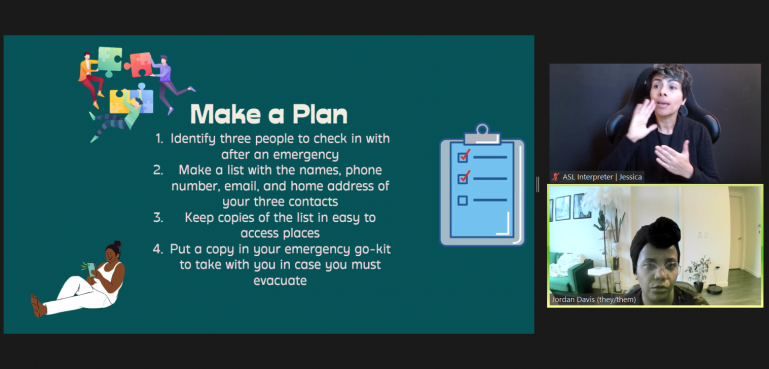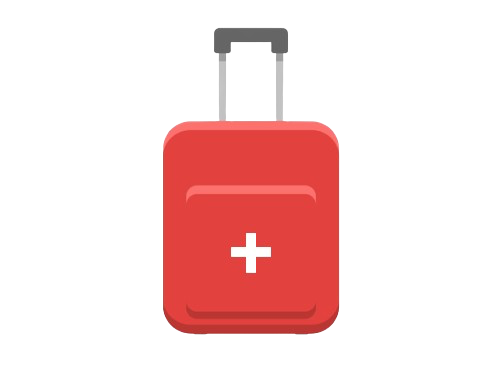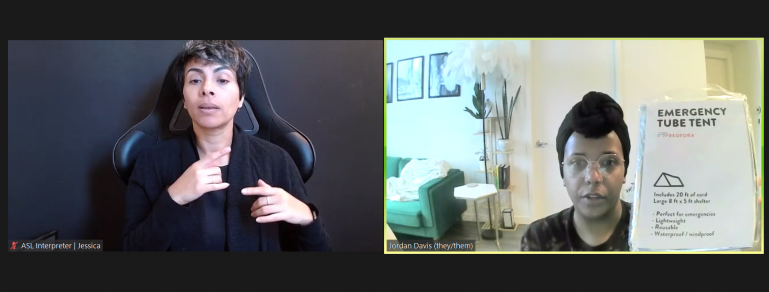Disaster Training for People with Disabilities

Disaster Training for People with Disabilities
The best time to think about a natural disaster is before it happens. For folks with disabilities who live in rural parts of the state, preparation is especially important.
To help with planning, Disability Rights California Staff Attorney Jordan Davis created a disaster preparedness training for Regional Center clients.
The training is a virtual presentation that breaks down basic emergency preparation, easy ways to get started with disaster planning, and reviews the items participants will receive in an emergency go-kit. Davis, who joined DRC as an Equal Justice Works Fellow in the Disaster Resilience Program, said that so far, the training has reached 1,000 people who receive Regional Center services.
People with disabilities have specific needs when it comes to preparing for natural disasters, yet they are often considered an afterthought, if considered at all, when it comes to disaster preparation. The training helps to bridge the gaps that often leave people with disabilities out.
“Speaking as a person with a disability, we already know that we have to advocate for ourselves and make sure we're good,” Davis said about disaster preparedness.


The training is in partnership with Department of Developmental Services to serve Regional Center clients who live in high fire-hazard areas. Parts of the state that are rural and mountainous are considered high fire-hazard because the landscape, topography, and vegetation contribute to the likelihood of wildfires causing damage.

“There's so many parts of California that are at risk of fire and they're so rural, and that kind of makes them get forgotten about. So, if you add then, you’re disabled it's really, really isolating,” Davis said.
“And so, I like to make sure that we can reach those folks and make sure that we're thinking about them as well and preparing.”

The Training

Davis hosts the training virtually, and it’s offered in-person training at Regional Centers on a case-by-case basis. The training has been translated into Spanish and every training has an ASL interpreter and a Spanish interpreter. Throughout the training Davis emphasizes inclusivity by breaking down disaster preparation into small steps. Davis said that even something like signing up for emergency alerts is “one way you can start getting prepared that may not take too much time or too much effort.”
Once people complete the training, they receive a go-kit with enough supplies for one person to shelter in place or evacuate for three days.
The go-kits are rolling suitcases that include items such as:

- a tent
- sleeping bag
- portable radio that doubles as a flashlight and charger
- a water purifying straw
- small sewing kit
- Swiss Army knife
- and more
The go-kits are provided to each participant through a partnership with the Department of Developmental Services (DDS) that focuses on sharing information with Regional Center clients who live in high fire-risk areas.
In addition to the dozens of emergency preparedness items included in the kits, there are other disability-specific items that Davis discusses during the training to get participants to think about items they might need. Davis shares ideas for disability-specific items like backup power sources, several days of prescription medications, a list of all medications, dosages, and allergies, and more.
To find disability-specific preparation information, click here.
In addition to adding items to an emergency kit, there are other steps that people with disabilities can take to prepare for emergencies. Davis recommends making a list of contacts who you can reach out to and who can check up on you during emergencies. They said that something as simple as being someone’s point of contact can “make a huge difference.”
Year-Round Preparedness

Caption: Davis speaking on the importance of an emergency tube tent.
The disaster training underscores the importance of year-round preparedness, as California increasingly faces extreme weather events and disasters during times of the year that were once considered the off-season. Davis shared the example of a tropical storm warning that hit Southern California in August 2023 as proof of the need for preparedness.

“I think is really the fact that we're starting to see kind of like other disasters we haven't seen,” Davis said.
“We look at the tropical storm, that's not something that happens often, but with climate change, people need to start getting used to that.

Another state familiar with natural and man-made disaster events is Texas. Stephanie Duke works as a Supervising Attorney and Disaster Resilience Coordinator for Disability Rights Texas. She shared that being prepared involves asking the right questions to the right people, such as those who rely on nursing services or live in group homes. Duke stresses reaching out to your local jurisdiction’s emergency management to find out what services they provide like emergency shelters and whether those operations will be accessible.

“Can I expect someone to show up if I shelter in place? Or do I have to get to an emergency sheltering operation that can provide,” Duke shared.
“So, then the next step would be, well, is my local emergency sheltering operation going to be accessible?”

Duke said that in today’s ever-evolving disaster landscape, the best time to prepare for a disaster is in “blue sky times” when things are not in crisis. Davis echoed that sentiment, noting that practicing what you will do during a disaster can help because once it’s happening “everything goes out the window that you prepared.”
Find more information about disaster preparation here.




